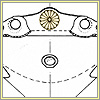

|
|
1. Symbol of Glory
A golden, chrysanthemum-shaped shield more than six feet in diameter protruded
from the ship's bow and was visible for miles. Such "Kikusui" crests, named for
a hero and martyr of the 14th century, appeared on only the most important
ships of the Imperial Navy—battleships, aircraft carriers, and cruisers.
The only other element of the ship painted gold was the ship's name, which like
the crest was a powerful symbol. "Yamato" is a poetic, even mystical synonym
for Japan itself.
|
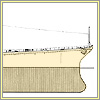

|
|
2. Gigantic Hull
If greatness can be measured by size, Yamato was indeed the greatest
battleship ever built. Her hull was 863 feet long—longer than all but
America's Iowa-class ships. Fully loaded, Yamato displaced about
70,000 tons of water, outweighing even the biggest Allied battleships by more
than 20 percent. Her hull was so immense that in the mid-1930s no Japanese
shipyard could contain it. A dry dock in Kure had to be deepened by several
feet before construction could begin.
|
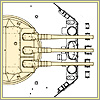

|
|
3. Big Guns
Yamato's nine main guns, mounted in three turrets, were the largest to
ever crown a warship. They fired shells 18 inches in diameter, and each
armor-piercing shell weighed as much as a small car. They also could strike at
an unprecedented range of 25 miles. Ironically, while designed to sink enemy
battleships, they were never tested against one. Yamato fought Allied
ships only once, in the Battle of Samar Gulf, where she sank one American
escort carrier and one destroyer. For her final mission, the Imperial Navy
swapped out some armor-piercing projectiles for incendiary, anti-aircraft
shells, but Yamato's awesome guns were still ill equipped for aerial
warfare.
|
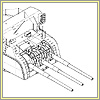

|
|
4. Secondary Guns
While dwarfed by the main artillery, Yamato's secondary armament was
still impressive. Her six-inch guns—that is, guns firing shells six
inches in diameter—had a range of 17 miles. And her 24 five-inch guns,
mounted in 12 turrets, could destroy targets nine miles away. The secondary
guns had one significant advantage over the main artillery: they could shoot
more rounds per minute. It took at least 40 seconds to load and fire one shot
from the main guns, an interminable time during an air attack.
|
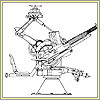

|
|
5. Anti-Aircraft Guns
When first outfitted in 1941, Yamato had only 24 small anti-aircraft
machine guns. By April 1945, anticipating an onslaught of Allied planes, the Imperial Navy armed Yamato with more than 150 machine guns, most in
triple-mounted turrets. The majority of the guns shot 220 rounds per minute,
but a few stationed at the tower bridge fired at twice this rate. Unlike the
heavier artillery, the machine guns could tilt at 90-degree angles to aim at
planes directly overhead. But the crews manning these guns were among the most
vulnerable to direct enemy fire.
|
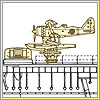

|
|
6. Aircraft & Catapults
The seven floatplanes Yamato carried were not fighter planes capable of
protecting her. They were designed for reconnaissance and to help direct
Yamato's guns to distant targets. The range of her big guns was so
enormous—25 miles—that spotter planes were essential for homing in
on enemy ships over the horizon. Two immense catapults—as tall as
six-story buildings when raised—launched the planes, and an equally
enormous crane lifted them from the water upon their return to the ship.
|
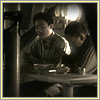

|
|
7. Living Conditions
Yamato had a reputation as the most comfortable ship in the Japanese
navy. For part of the war, she was the navy's flagship and home to the highest
naval commanders, who were catered to. But even low-ranking sailors fared
well—eating white rice rather than barley—because Yamato
spent many months in port. She was the first Japanese warship equipped with air
conditioning, although it didn't cool all living quarters. There was also
relative elbow room for her crew of 2,800 men: 10 square feet of living space
per man, compared to only three to four square feet on Japanese destroyers.
|
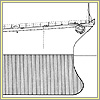

|
|
8. Bulbous Bow
Yamato's vast width posed a challenge: her designers had to come up with
a hydrodynamic bow to help the ship cut through the water. They tested 50
different wax models and struck upon a bow shape that greatly reduced drag at
the front of the ship. The bulbous bow, jutting out 10 feet, creates its own
wave that cancels out another wave generated by the main part of the ship. Less
hindered by wave resistance, Yamato could reach a top speed of nearly 28
knots (32 mph), extraordinary at the time for a ship of her size.
|
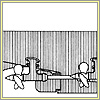

|
|
9. Engine Power
A system of four steam turbine engines, with a staggering 150,000 horsepower,
propelled the massive ship. Twelve boilers, heating steam to 700°F, fed
the four engines, which then moved an array of propellers. Each propeller blade
was nearly three times as long as a man of average height. At Yamato's
maximum speed of 32 mph, the propulsion system consumed 70 tons of fuel oil
every hour.
|
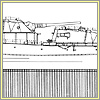

|
|
10. Heavy Armor
The ship's steel armor weighed 23,000 tons—more than 30 percent of
Yamato's total weight. The Imperial Navy developed new ways to harden
steel and otherwise improve armor technology for the ship. Plates of armor 25
inches thick—the heaviest armor ever mounted on a warship—shielded
the turrets of her main guns. The side of the ship could survive the impact of
3,000-pound armor-piercing projectiles like those shot from the ship's big
guns. But Yamato's bow and stern were not as well protected. Most of the
torpedoes that ultimately sank the ship struck there, below the waterline,
where she was most vulnerable.
|
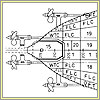

|
|
11. Flood Control
Yamato's 1,150 watertight compartments were meant not just to prevent
unwanted flooding but, in some cases, to purposely be flooded. If the ship
listed to one side, water could be pumped into compartments on the opposite
side. Fuel could also be transferred to tanks on the upward side to help
counter the tilt. Midway through Yamato's last battle, as the ship
listed 15 degrees to port, her crew relied on the system to reduce the tilt to
five degrees. But soon all the flood-control compartments on the starboard side
were filled, and more torpedo hits and flooding on the port side capsized the
ship.
|
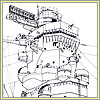

|
|
12. Tower Bridge
The tower bridge was the ship's control center. Perched at its top, 100 feet
above the weather deck, was a rangefinder with state-of-the-art optics. Similar
rangefinders aided targeting at Yamato's three main gun turrets. Their
range estimation would have been critical in battles with distant enemy ships.
But like Yamato's modern radar and sonar equipment, the rangefinders
were little help in her final showdown with Allied planes. Yamato
veteran Naoyoshi Ishida, who was stationed on the tower bridge, could see the
American pilots with his unaided eyes.
|
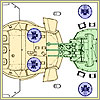

|
|
13. Placement of Guns
|

| 
|

